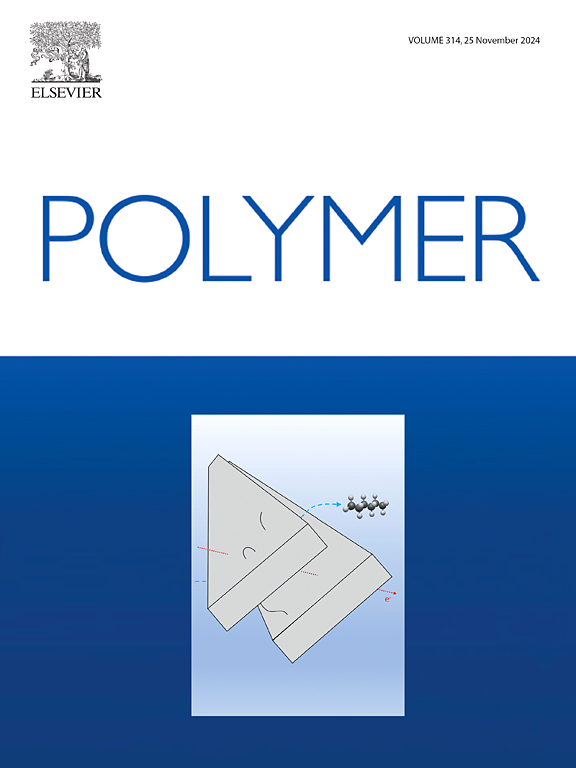Floral-structured bimetallic Co/Ni@CuBTC for enhancing the EMW absorption and fire safety of epoxy: an integrated solution for radar stealth, fire retardant and thermal management
IF 4.5
2区 化学
Q2 POLYMER SCIENCE
引用次数: 0
Abstract
For the application of intelligent equipment in fire rescue and anti-terrorism, the urgent need of shell materials with comprehensive performance, including radar wave absorption and fire safety, is raised. This study presents the epoxy resin (EP) composite incorporating a floral-structured bimetallic Co/Ni@CuBTC (ACM) with enhanced EMW absorption, flame retardancy and thermal management. The results show that the absorption rate of ACM at 3 mm thickness reaches -42.25 dB for 11.5 GHz EMW, and the dissipation to radar waves at -180o to 180o in radar cross section (RCS) simulation reaches -40.2 dB. The EP composite with 5 wt% ACM can block cell phone (800 MHz) and Bluetooth signals (2.4 GHz) at 3 mm thickness. The EP composite with 3 wt% ACM-3 (EP/ACM 3 %) presented the lowest peak heat release rate of 811.2 kW·m-2, which decreased by 39.5 % compared with pure EP, meanwhile it reached the V-1 rate in UL-94 test, showing a significant improvement in flame retardancy. The thermal conductivity (λ) of EP/ACM 3 % reached 0.811 Wm-1K-1, which is 21.9 % higher than that of pure EP, reducing the risk of heat accumulation. The EP/ACM composite, with its integrated capabilities in EMW absorption, flame retardant and thermal management, holds promising applications in unmanned fire rescue and anti-terrorism in future.

花卉结构双金属Co/Ni@CuBTC用于增强环氧树脂的EMW吸收和防火安全性:雷达隐身,阻燃和热管理的集成解决方案
对于智能装备在消防救援和反恐中的应用,迫切需要具有综合性能的外壳材料,包括雷达波吸收和防火安全。本研究提出了一种含有花结构双金属Co/Ni@CuBTC (ACM)的环氧树脂(EP)复合材料,具有增强的EMW吸收,阻燃性和热管理能力。结果表明,在11.5 GHz EMW下,ACM在3 mm厚度处的吸收率达到-42.25 dB,在雷达截面(RCS)仿真中,对-180 ~ 180度雷达波的耗散达到-40.2 dB。含有5 wt% ACM的EP复合材料可以在3mm厚的情况下阻挡手机(800 MHz)和蓝牙(2.4 GHz)信号。添加3 wt% ACM-3 (EP/ACM 3%)的EP复合材料的峰值放热率最低,为811.2 kW·m-2,比纯EP降低了39.5%,同时在UL-94试验中达到V-1级,阻燃性能显著提高。EP/ACM 3%的导热系数λ达到0.811 Wm-1K-1,比纯EP高21.9%,降低了积热风险。EP/ACM复合材料具有EMW吸收、阻燃和热管理的综合能力,未来在无人消防救援和反恐方面具有广阔的应用前景。
本文章由计算机程序翻译,如有差异,请以英文原文为准。
求助全文
约1分钟内获得全文
求助全文
来源期刊

Polymer
化学-高分子科学
CiteScore
7.90
自引率
8.70%
发文量
959
审稿时长
32 days
期刊介绍:
Polymer is an interdisciplinary journal dedicated to publishing innovative and significant advances in Polymer Physics, Chemistry and Technology. We welcome submissions on polymer hybrids, nanocomposites, characterisation and self-assembly. Polymer also publishes work on the technological application of polymers in energy and optoelectronics.
The main scope is covered but not limited to the following core areas:
Polymer Materials
Nanocomposites and hybrid nanomaterials
Polymer blends, films, fibres, networks and porous materials
Physical Characterization
Characterisation, modelling and simulation* of molecular and materials properties in bulk, solution, and thin films
Polymer Engineering
Advanced multiscale processing methods
Polymer Synthesis, Modification and Self-assembly
Including designer polymer architectures, mechanisms and kinetics, and supramolecular polymerization
Technological Applications
Polymers for energy generation and storage
Polymer membranes for separation technology
Polymers for opto- and microelectronics.
 求助内容:
求助内容: 应助结果提醒方式:
应助结果提醒方式:


